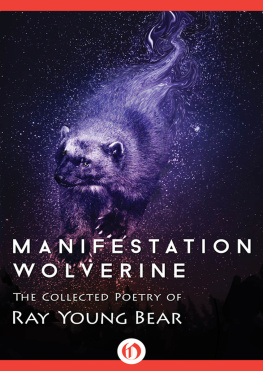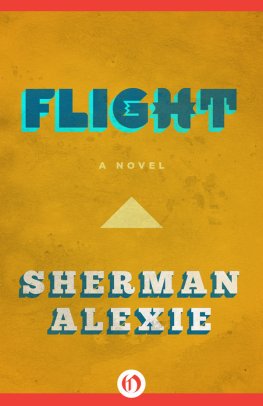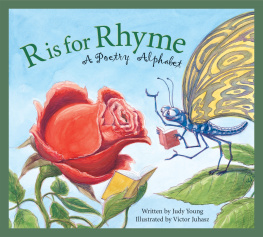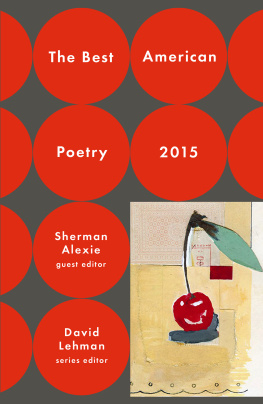MANIFESTATION WOLVERINE THE COLLECTED POETRY OF RAY YOUNG BEAR

CONTENTS *concrete poem Akwi ma - na ta wi - a sa mike ko- i na tti mo ya ni ni - ayo tte ski-ne ko kwe te bya i ki There are no elucidations or foresights here merely experiments with words Publishers Note Long before they were ever written down, poems were organized in lines. Since the invention of the printing press, readers have become increasingly conscious of looking at poems, rather than hearing them, but the function of the poetic line remains primarily sonic. Whether a poem is written in meter or in free verse, the lines introduce some kind of pattern into the ongoing syntax of the poems sentences; the lines make us experience those sentences differently. Reading a prose poem, we feel the strategic absence of line. But precisely because weve become so used to looking at poems, the function of line can be hard to describe. As James Longenbach writes in
The Art of the Poetic Line, Line has no identity except in relation to other elements in the poem, especially the syntax of the poems sentences.
It is not an abstract concept, and its qualities cannot be described generally or schematically. It cannot be associated reliably with the way we speak or breathe. Nor can its function be understood merely from its visual appearance on the page. Printed books altered our relationship to poetry by allowing us to see the lines more readily. What new challenges do electronic reading devices pose? In a printed book, the width of the page and the size of the type are fixed. Usually, because the page is wide enough and the type small enough, a line of poetry fits comfortably on the page: What you see is what youre supposed to hear as a unit of sound.
Sometimes, however, a long line may exceed the width of the page; the line continues, indented just below the beginning of the line. Readers of printed books have become accustomed to this convention, even if it may on some occasions seem ambiguousparticularly when some of the lines of a poem are already indented from the left-hand margin of the page. But unlike a printed book, which is stable, an ebook is a shape-shifter. Electronic type may be reflowed across a galaxy of applications and interfaces, across a variety of screens, from phone to tablet to computer. And because the reader of an ebook is empowered to change the size of the type, a poems original lineation may seem to be altered in many different ways. As the size of the type increases, the likelihood of any given line running over increases.
Our typesetting standard for poetry is designed to register that when a line of poetry exceeds the width of the screen, the resulting run-over line should be indented, as it might be in a printed book. Take a look at John Ashberys Disclaimer as it appears in two different type sizes.  Each of these versions of the poem has the same number of lines: the number that Ashbery intended. But if you look at the second, third, and fifth lines of the second stanza in the right-hand version of Disclaimer, youll see the automatic indent; in the fifth line, for instance, the word ahead drops down and is indented. The automatic indent not only makes poems easier to read electronically; it also helps to retain the rhythmic shape of the linethe unit of soundas the poet intended it. And to preserve the integrity of the line, words are never broken or hyphenated when the line must run over.
Each of these versions of the poem has the same number of lines: the number that Ashbery intended. But if you look at the second, third, and fifth lines of the second stanza in the right-hand version of Disclaimer, youll see the automatic indent; in the fifth line, for instance, the word ahead drops down and is indented. The automatic indent not only makes poems easier to read electronically; it also helps to retain the rhythmic shape of the linethe unit of soundas the poet intended it. And to preserve the integrity of the line, words are never broken or hyphenated when the line must run over.
Reading Disclaimer on the screen, you can be sure that the phrase you pause before the little bridge, sigh, and turn ahead is a complete line, while the phrase you pause before the little bridge, sigh, and turn is not. Open Road has adopted an electronic typesetting standard for poetry that ensures the clearest possible marking of both line breaks and stanza breaks, while at the same time handling the built-in function for resizing and reflowing text that all ereading devices possess. The first step is the appropriate semantic markup of the text, in which the formal elements distinguishing a poem, including lines, stanzas, and degrees of indentation, are tagged. Next, a style sheet that reads these tags must be designed, so that the formal elements of the poems are always displayed consistently. For instance, the style sheet reads the tags marking lines that the author himself has indented; should that indented line exceed the character capacity of a screen, the run-over part of the line will be indented further, and all such runovers will look the same. This combination of appropriate coding choices and style sheets makes it easy to display poems with complex indentations, no matter if the lines are metered or free, end-stopped or enjambed.
Ultimately, there may be no way to account for every single variation in the way in which the lines of a poem are disposed visually on an electronic reading device, just as rare variations may challenge the conventions of the printed page, but with rigorous quality assessment and scrupulous proofreading, nearly every poem can be set electronically in accordance with its authors intention. And in some regards, electronic typesetting increases our capacity to transcribe a poem accurately: In a printed book, there may be no way to distinguish a stanza break from a page break, but with an ereader, one has only to resize the text in question to discover if a break at the bottom of a page is intentional or accidental. Our goal in bringing out poetry in fully reflowable digital editions is to honor the sanctity of line and stanza as meticulously as possibleto allow readers to feel assured that the way the lines appear on the screen is an accurate embodiment of the way the author wants the lines to sound. Ever since poems began to be written down, the manner in which they ought to be written down has seemed equivocal; ambiguities have always resulted. By taking advantage of the technologies available in our time, our goal is to deliver the most satisfying reading experience possible. the purple scarf and the plastic shopping bag. if i felt hands on my head id know that those were her hands warm and damp with the smell of roots. if i heard a voice coming from a rock id know and her words would flow inside me like the light of someone stirring ashes from a sleeping fire at night. if i heard a voice coming from a rock id know and her words would flow inside me like the light of someone stirring ashes from a sleeping fire at night.
PAINTED VISIONS faraway trains ring the existence of time. inside the cold end of a small rainbow we stood like lonely eagles huddled against each other, wishing to ourselves a gentle warm stove, images of our participation within the human world. all of us, standing in a cluttered room, standing away from the sound of our talons scraping the frost from the earth. we turned to the people and mumbled something about the little girl who said she could hold her breath forever and that she knew the very thoughts of a blackbird with dreams of the day it will skiprope on a sidewalk. once those years of sharp rivers took me to a place of caged bears who sang an endless song to us about the blank shield without our painted visions. the bitter knife will recede. in the brilliance of summer: the earth performs its life and death. the house stands unpainted. we stand on the bridge made by the gods of the cold rock, the cold underwater. we regather a lost rainbow. we walk somewhere near the lightning and our hearts imagine themselves as fire-burnt cottonwood trees. to the north beyond the wall of this room, a purple night-fire burns in glory and our ignorance feeds it, sustains it. i grow back into a child. i cannot name the people around me. the differences in our life. the things which keep us in circles. broken pieces which once belonged to us. broken pieces which once belonged to us.











 CONTENTS *concrete poem Akwi ma - na ta wi - a sa mike ko- i na tti mo ya ni ni - ayo tte ski-ne ko kwe te bya i ki There are no elucidations or foresights here merely experiments with words Publishers Note Long before they were ever written down, poems were organized in lines. Since the invention of the printing press, readers have become increasingly conscious of looking at poems, rather than hearing them, but the function of the poetic line remains primarily sonic. Whether a poem is written in meter or in free verse, the lines introduce some kind of pattern into the ongoing syntax of the poems sentences; the lines make us experience those sentences differently. Reading a prose poem, we feel the strategic absence of line. But precisely because weve become so used to looking at poems, the function of line can be hard to describe. As James Longenbach writes in The Art of the Poetic Line, Line has no identity except in relation to other elements in the poem, especially the syntax of the poems sentences.
CONTENTS *concrete poem Akwi ma - na ta wi - a sa mike ko- i na tti mo ya ni ni - ayo tte ski-ne ko kwe te bya i ki There are no elucidations or foresights here merely experiments with words Publishers Note Long before they were ever written down, poems were organized in lines. Since the invention of the printing press, readers have become increasingly conscious of looking at poems, rather than hearing them, but the function of the poetic line remains primarily sonic. Whether a poem is written in meter or in free verse, the lines introduce some kind of pattern into the ongoing syntax of the poems sentences; the lines make us experience those sentences differently. Reading a prose poem, we feel the strategic absence of line. But precisely because weve become so used to looking at poems, the function of line can be hard to describe. As James Longenbach writes in The Art of the Poetic Line, Line has no identity except in relation to other elements in the poem, especially the syntax of the poems sentences.  Each of these versions of the poem has the same number of lines: the number that Ashbery intended. But if you look at the second, third, and fifth lines of the second stanza in the right-hand version of Disclaimer, youll see the automatic indent; in the fifth line, for instance, the word ahead drops down and is indented. The automatic indent not only makes poems easier to read electronically; it also helps to retain the rhythmic shape of the linethe unit of soundas the poet intended it. And to preserve the integrity of the line, words are never broken or hyphenated when the line must run over.
Each of these versions of the poem has the same number of lines: the number that Ashbery intended. But if you look at the second, third, and fifth lines of the second stanza in the right-hand version of Disclaimer, youll see the automatic indent; in the fifth line, for instance, the word ahead drops down and is indented. The automatic indent not only makes poems easier to read electronically; it also helps to retain the rhythmic shape of the linethe unit of soundas the poet intended it. And to preserve the integrity of the line, words are never broken or hyphenated when the line must run over.